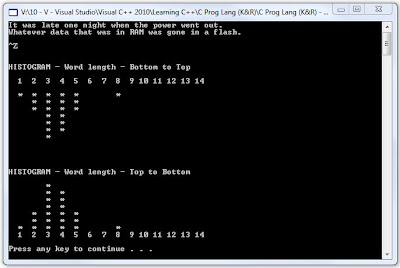I’m making my way through “The C Programming Language” by Brian
Kernighan and Dennis Ritchie aka K&R.
Exercise 1-13.
Write a program to print a histogram of the
lengths of words in its input. It is easy to draw the histogram with the bars
horizontal; a vertical orientation is more challenging.
My previous entry (here)
was one answer to this exercise. This entry takes the previous code and makes
two changes.
1. Display the histogram vertically instead of horizontally.
2. Fix a bug in the word parsing.
Displaying the histogram vertically is more difficult. In
the previous code, you only looked at one length of word at a time. Start with
the count for 1 letter words and print as many asterisks as needed. Then go to
the 2 letter words and so on. And there were 14 such categories so you loop 14
times for each length. Straightforward. Not so with a vertical display.
Here you have to add each row for all the word lengths which
may have a value or not. That means choosing to print an asterisk or space. So
row by row you check each word length to see if there’s an asterisk to add. But
how long do you keep this up? It’s not the size of the array. It’s the maximum
value in the any one of the elements. There may be 30 three-letter words and 20
four-letter words. You don’t stop at 20. To figure that out I introduced a variable,
maxrows, and looped through the
array to find the largest count value. If that’s 20, then there has to be one
column with 20 asterisks.
As for the bug, the previous code focused on whitespace.
Anything that wasn’t whitespace formed a word or part of a word. It shouldn’t.
I wanted to change the code so all punctuation and the like were also ignored.
So my IsWhitespace
function became IsNoneWordChar. But instead of testing for exclusions
like say, a period, I tested for valid word characters (i.e., a-z, A-Z, 0-9).
Same effect, but different approach.
One of the toughest parts was getting the histogram to line
up in the right columns. It took some doing, but I finally figured what was
needed.
Sample Code.
I am using Visual C++ 2010 and created the sample code as a
console application.
//
Function prototypes
bool IsNoneWordChar(char);
// The
standard library includes the system function.
#include <cstdlib>
// C++
standard I/O library.
#include <cstdio>
int main()
{
// Character
input.
char c = 0;
// Previous
character.
char
prevChar = 0;
// Word Length.
int
WordLength = 0;
int
WordLengthCount[15];
// Initialize
array with zero.
for (c = 0;
c < 15; ++c)
WordLengthCount[c] = 0;
// Process user
input from keyboard.
while ((c =
getchar()) != EOF) {
if
(IsNoneWordChar(c))
if
(IsNoneWordChar(prevChar))
//
Ignore extra non-word char.
; //
Null stmt.
else
{
//
Prev char word char.
//
Means end of word.
//
Store length in array.
if
(WordLength < 14)
++WordLengthCount[WordLength];
else
// Words 14 chars or longer.
++WordLengthCount[14];
//
Reset for new word.
WordLength = 0;
}
else
{
// Is
a word char, therefore not end of word.
//
Increment counter for word length.
++WordLength;
}
// Set prev
char to current.
prevChar = c;
} // end while
// Display
histogram.
printf("\n\nHISTOGRAM
- Word length - Bottom to Top\n\n");
// Counters.
int i, col;
int maxrows
= 0;
// Find max rows.
for (i = 1;
i < 15; ++i) {
if
(WordLengthCount[i] > maxrows)
maxrows = WordLengthCount[i];
}
// Bottom to top
approach.
// Loop through
the 14 word length categories
// and display
the number as label.
for (i = 1;
i < 15; ++i) {
// Label
if (i
< 10)
printf(" %d", i);
else
printf("
%d", i);
}
printf("\n\n");
// Loop row by
row, count 1, 2, 3...max
// One column for
each length of word.
for (i= 1;
i <= maxrows; ++i) {
for
(col = 1; col < 15; ++col) {
if
(WordLengthCount[col] >= i)
printf(" *");
else
printf(" ");
}
printf("\n");
}
printf("\n\n");
// Top to bottom
approach.
// Header.
printf("\n\nHISTOGRAM
- Word length - Top to Bottom\n\n");
// Loop row by
row, count max to 1.
// One column for
each length of word.
for (i=
maxrows; i > 0; --i) {
for
(col = 1; col < 15; ++col) {
if
(WordLengthCount[col] >= i)
printf(" *");
else
printf(" ");
}
printf("\n");
}
// Loop through
the 14 word length categories
// and display
the number as label.
for (i = 1;
i < 15; ++i) {
// Label
if (i
< 10)
printf(" %d", i);
else
printf("
%d", i);
}
printf("\n\n");
// Keep console
window open.
system("pause");
// Return some
value.
return 0;
} // end main
Output.
To show the word parsing has been fixed.
I wrote the code starting from the top down because it was
easier to see if it was working. I then reversed the print loop to display it
in a more traditional way. You can compare each method.


No comments:
Post a Comment